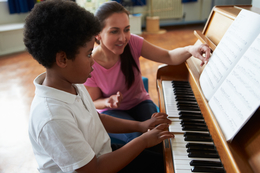|
November 29, 2017 Vol. 3
 Response to Senate
File 274
Recommendations
strengthen computer science education
With the
intent of improving the opportunity for all students to develop computer
science knowledge and skills, a work group has offered recommendations required
by Senate File 274. In addition to establishing the work group, the legislation
passed last spring also created a professional development incentive fund. The
goal of the fund is to significantly increase the number of computer science
teachers in Iowa.
The group was
required to address the following five issues, which they did in their final report.
How computer science courses could
satisfy graduation requirements for math or science. The group determined that a
district could allow students to count a computer science course for
mathematics or science credit once that student has completed other mathematics or science classes
covering required mathematics or science standards.
How these courses could be
integrated into a career and technical education (CTE) pathway. Currently, a computer science course
can count in a CTE program as long as the teacher has a CTE endorsement. The
work group recommends strengthening communications between the Department, the
Iowa Board of Educational Examiners, and school districts to ensure schools
know how computer science courses can be integrated into a CTE pathway.
The settings in which courses could
be delivered (including in traditional high school settings, concurrent
enrollment classes, and online). For
districts receiving the computer science professional development incentive
funds, professional learning will be available for those that want to offer
traditional and/or blended delivery.
Guidelines for an appropriate scope
and sequence of computer science instruction at each grade level. A team of computer science
education experts is now being assembled to review computer science standards
and use the K-12
Computer Science Framework
as a guiding document to recommend standards for Iowa’s schools.
How the computer science
professional development fund created in the legislation could be used to meet
the goals of the law. The funds will be disbursed through
a competitive application process. Priority will be given to districts that
most clearly demonstrate that their proposal will expand the reach and rigor of
computer science, including expanding participation for underrepresented
students. In addition, the Department must distribute funds evenly across
small, medium, and large districts and ensure geographic diversity among the
accepted applications. The legislature plans to appropriate money to this fund
in the upcoming legislative session.
For more information, contact Ryan Wise at ryan.wise@iowa.gov or (515) 281-3436 or Erika Cook at erika.cook@iowa.gov or (515) 240-3103.
|
 First for Fine Arts
K-12 fine arts standards adopted by State Board
Recommended fine arts
standards for students in preschool through grade 12 are now a part of Iowa’s
academic standards. The State Board of Education voted to adopt the new
standards Nov. 15.
A team of 22
Iowa fine arts educators reviewed the National
Core Art Standards
(NCAS) and recommended their adoption with some minor revisions. The new Fine
Arts Standards include visual art, vocal and instrumental music, dance, media
arts, and theatre.
The
standards, which emphasize artistic literacy and artistic thinking, are
process-focused instead of product-focused. Standards for all disciplines
center around four artistic processes: creating, performing/producing/presenting,
responding, and connecting. The standards are designed to provide a unified
approach to fine arts that will support a level playing field for students, regardless of variance in fine arts programs across the state.
Angela
Matsuoka, fine arts consultant for the Department of Education, led the work of
the team assisted by Rhonda Sternhagen, visual arts teacher from Grundy Center
CSD, and Jill Wilson, assistant professor of music at Luther College. Matsuoka
described the importance of the standards as “paramount to education. The
standards identify pathways for students to become critical thinkers, creative
makers, and thoughtful responders to the world around them,” she said.
Iowans
surveyed seemed to agree with Matsuoka. In an online survey of Fine Arts
teachers conducted by the Department between April 13 and May 12, 86 percent of
the responders indicated they believed recommended standards for fine arts will
lead to improved student learning.
Leon
Kuehner, Iowa Alliance for Arts Education executive director, served as a team
member and assisted with the presentation to the State Board. According to
Kuehner, this adoption underscores the importance of the fine arts “as part of
a well-rounded education and affirms the value of fine arts in our state.”
For more information, contact Angela.Matsuoka at angela.matsuoka@iowa.gov or (515) 782-7296.
|
 Supporting writing
standards
Literacy
team to focus on improving writing instruction
One of the
goals of the Statewide Literacy Leadership Team is to improve student writing
and learning by improving the teaching of writing. To support this goal, team
members will participate in a standards-aligned professional learning
opportunity facilitated by Gary Troia, an associate professor at Michigan State
University, whose work includes writing instruction and assessment to meet
post-secondary writing expectations.
The session, planned for Feb. 15, 2018, is designed for AEA and district
leads to build their knowledge in evidence- and research-based writing
instruction and assessment using a Multi-Tiered System of Support
decision-making framework.
The focus
on writing is much needed, according to Destiny Eldridge, literacy consultant
for the Iowa Department of Education. "I’ve
received feedback from educators that writing instruction and student
opportunities to write regularly across all disciplines and for real purposes is lacking
in Iowa,” she said. Eldridge also indicated that the anticipated
standards-aligned statewide assessment will include a writing component when
implemented in 2018.
Based upon
the session, the team plans to build a workshop to deliver to teacher leaders,
instructional coaches, and teachers designed to build their capacity in the following areas:
- Understanding
the writing standards, including the interdependence among reading, writing,
speaking and listening
- Implementing
research- and evidence-based instructional practices and writing strategies
- Assessing
writing
Eldridge
anticipates that members of the Statewide Literacy Leadership Team will be ready to facilitate this workshop with educators in June 2018.
For more information, contact Destiny Eldridge at destiny.eldridge@iowa.gov or (515) 822-2554.
|
Teacher leadership and compensation
Key to successful teacher leadership is collaboration
A centerpiece of the Teacher Leadership and Compensation (TLC) program is collaboration. One of the five state TLC goals is to promote collaboration by developing and supporting opportunities for teachers in schools and school districts statewide to learn from each other. A common role for a teacher leader is to help create a culture to support shared leadership and collaboration.
Here are some teacher leader roles to support collaboration suggested in "10 Obstacles to Collaboration: the Role of a Teacher Leader" from k12teacherleadership, April 2016.
- Encourage teachers to share their ideas and practices by building a relationship to decrease the teacher’s resistance to engage in collaboration.
- Educate teachers about the advantages for collaboration and its simplicity.
- Clearly communicate the purpose and vision of school-wide collaboration and how it promotes teacher development.
- Support the school principal and other leaders in implementing collaboration that impacts student learning and professional practice.
- Advocate for time, space, and resources toward collaborative efforts.
- Embed professional learning and collaboration into daily practice.
- Facilitate opportunities of collaboration to ensure that the experience is positive. Furthermore, collect feedback from all teachers to identify ways to continuously improve collaboration.
- Work with teachers to develop group norms and ensure collaboration is open to diverse perspectives.
A collaborative culture is built in teachers’ willingness to share support and explore together. This type of culture will increase teacher retention, improve student learning, and improve professional learning.
For more information, contact Lora Rasey at lora.rasey@iowa.gov or (515) 281-6719.
 District builds a culture of collaborative improvement
A district that exemplifies the collaborative culture that is part of the Teacher Leadership and Compensation (TLC) Framework for Learning Supports is the Humboldt Community School District.
Humboldt CSD is in the fourth year of TLC funding and has built their TLC programming around their focus on Authentic Intellectual Work (AIW). Now in its tenth year of AIW implementation, Humboldt's preschool through high school teachers engage in this reflective, continuous improvement process.
“AIW focuses us on improving the quality of teaching to help students develop higher order thinking, demonstrate conceptual understanding of important disciplinary content, and engage in substantive conversations,” said Tamela Johnson, Humboldt curriculum director. “All of us, whether we’re curriculum leads, mentor teachers, technology integrationists, data coaches, or instructional coaches are looking at teaching and learning through the AIW lens. We’re talking the same language and working toward the same end.”
Through professional learning communities, teachers apply the AIW standards and criteria to score tasks, student work, and instruction. Through this process they develop instructional expertise around a common vision of quality instruction supported by research and aimed at improving academic achievement. Trust grows among team members as they solicit and give descriptive feedback about each other’s teaching.
Following the scoring sessions, teachers use the feedback they’ve received to improve the task or instructional plan. Over time teachers, individually and collectively, become more reflective and apply AIW to everyday classroom practices.
Johnson said that TLC funding has been especially important in allowing the district to send coaches for additional training. “Building internal capacity has been a huge part of our success,” she said. “We’ve been doing this for a long time and we’re still having great conversations,” Johnson said. “It’s the wisdom around the table that keeps moving us forward.”
|
|